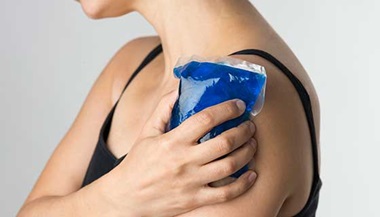Partial Rotator Cuff Tear
What You Need to Know
- Rotator cuff tendons inside the shoulder may wear down with age, which may lead to partial rotator cuff tears.
- Some partial rotator cuff tears may go unnoticed because they don’t always cause pain.
- A condition called frozen shoulder can sometimes mimic the symptoms of partial rotator cuff tears.
- Treatment is not necessary if there is no pain associated with the partial rotator cuff tear.
- Surgery is rarely necessary.
What is the rotator cuff?
The rotator cuff muscles attach to the shoulder blade and turn into tendons that attach to the top of the arm bone (humerus) near the shoulder socket. When the rotator cuff muscles contract and pull on the tendons, the tendons then pull on the bone. This pull helps the arm (humerus) move.
There are four rotator cuff muscles and thus there are four rotator cuff tendons. The tendons are about 1 centimeter thick (as thick as your little finger) and about as wide as 2-3 centimeters (the width of two or three fingers). They attach to the humerus bone, around the top near the joint, and help the shoulder move.

How Rotator Cuff Tendons Change As You Age
Changes in the rotator cuff that weaken it occur around the age of 30 and increase after that. Many people are unaware of these changes because they don’t always cause pain. These changes can’t initially be seen without a microscope, but sometimes they can show up on an MRI scan.
MRI scans are read by a radiologist who refers to these early changes as “tendinosis.” Tendinosis changes are a normal part of the aging process and usually don’t need to be treated unless they cause pain.
Why Rotator Cuff Tendons Get Tears
It is not known why rotator cuff tendons develop tears, but it’s associated with aging. By the time someone is 60 years old, there is a good chance they have some partial tears or complete tears of the rotator cuff.
One common theory suggested that the tendon hits against bone spurs, but that is now considered an unlikely cause. Regardless of how these changes occur, tears happen to people from all walks of life and all occupations. As a result, the consensus is that changes in the rotator cuff with age are part of becoming more “mature.”
Occasionally, patients younger than 35 get partial tears of the rotator cuff. These tears may be associated with an injury. Partial rotator cuff tears are common in people who are overhead athletes (they play sports with an upper arm and shoulder arc over the head), such as pitchers in baseball. Partial rotator cuff tears in competitive athletes are treated the same way as partial tears in aging adults.
Difference Between Partial and Full Rotator Cuff Tears
A partial tear goes only part of the way into the tendon. It’s usually described in terms of how deep the tear is in the tendon and doesn’t refer to length, width or other dimensions. A full-thickness tear is when the wear in the tendon goes all the way through the tendon. Partial tears can be just 1 millimeter deep (only about 10 percent of a tendon), or can be 50 percent or deeper.
When a radiologist looks at an MRI scan, he or she must make a judgment about the type of the rotator cuff changes. They must decide if the changes are tendinosis, a partial tear or a full tear. Sometimes it is not possible to distinguish tendinosis from a partial tear, or a partial tear from a full tear. It takes experience and practice to be able to read MRI scans of the rotator cuff tendons.

Symptoms of Partial Rotator Cuff Tears
Not all patients with partial rotator cuff tears have symptoms, but those who do may experience pain in the shoulder. Generally, the most painful motion with a partial rotator cuff tear is lifting things over the shoulder level or far away from the body. Lifting in this manner is very stressful on the shoulder. Many activities may not hurt at all, including running, cycling, swimming, lifting weights, etc. If you do have pain, you can try cutting back on that exercise or activity, but there is no evidence that continuing the activity will worsen the tear.
Diagnosis of Partial Rotator Cuff Tears
MRI scans are most commonly used to diagnose partial rotator cuff tears. However, just because an MRI scan shows a tear doesn’t mean it is the cause of your shoulder pain.
The most common condition that mimics a rotator cuff tear is shoulder stiffness or a frozen shoulder. This condition is characterized by reduced range of motion — the shoulder will only move so far before starting to hurt. It is common for a patient to develop a stiff and painful shoulder with no injury.
A radiologist may read the resulting MRI scan as showing tendinosis or a partial tear of the rotator cuff. These findings, although they may be true, may have nothing to do with the source of the pain. Partial tears of the rotator cuff seen on MRI scans have meaning only if the symptoms and examination are consistent with that diagnosis. When the MRI finding has nothing to do with the patient’s problem, it is called an incidental finding.
What do partial rotator cuff tears look like?
As tendinosis increases, eventually it can be seen with the naked eye. When a tendon begins to tear, it looks like fibers of a rope that are splitting and fraying. Partial tears are very common and it’s not known why one person may have symptoms and another may not. One study that examined MRI scans from people over age 60 found that more than 50 percent had partial tears of their rotator cuff tendons and never knew it.
Should I worry about a partial rotator cuff tear found on an MRI?
The answer is generally “no,” as these partial tears are very common and considered part of the aging process. A finding of a partial tear of the rotator cuff is essentially normal in people over the age of 40. Partial tears that show up on MRI scans typically don’t need treatment as long as they don’t hurt or cause problems.
Treatment of Partial Rotator Cuff Tears
If there is no pain, then no treatment is necessary for a partial tear of the rotator cuff tendons. If the shoulder is painful, then you have several treatment options.
Nonsurgical treatments
Generally, partial tears of the rotator cuff are treated without surgery. The treatment is focused on maintaining the range of motion and preventing the shoulder from becoming stiff. It may include:
-
Stretching for five minutes every day to prevent stiffness.
-
Applying ice packs for pain relief for 20 to 30 minutes as often as every two hours, if needed.
-
Taking medication to help control pain.
-
Administering cortisone shots into the bursa near the rotator cuff tendons to reduce inflammation.
If the partial tear causes significant pain and these treatments don’t work, then physical therapy can be helpful. The goal of physical therapy is to help decrease pain and strengthen the muscles and tendons.
Physical therapy can also help increase motion of the shoulder, as sometimes stiffness is the cause of the pain and not the tendon. The exercises should not be painful or they are being done incorrectly.
When does a partial rotator cuff tear need surgery?
It is very uncommon to operate on a partial rotator cuff tear. In cases of deep partial tears — when more than 90 percent of the tendon is torn — surgery is recommended only if the symptoms can’t be controlled with nonsurgical treatments.






